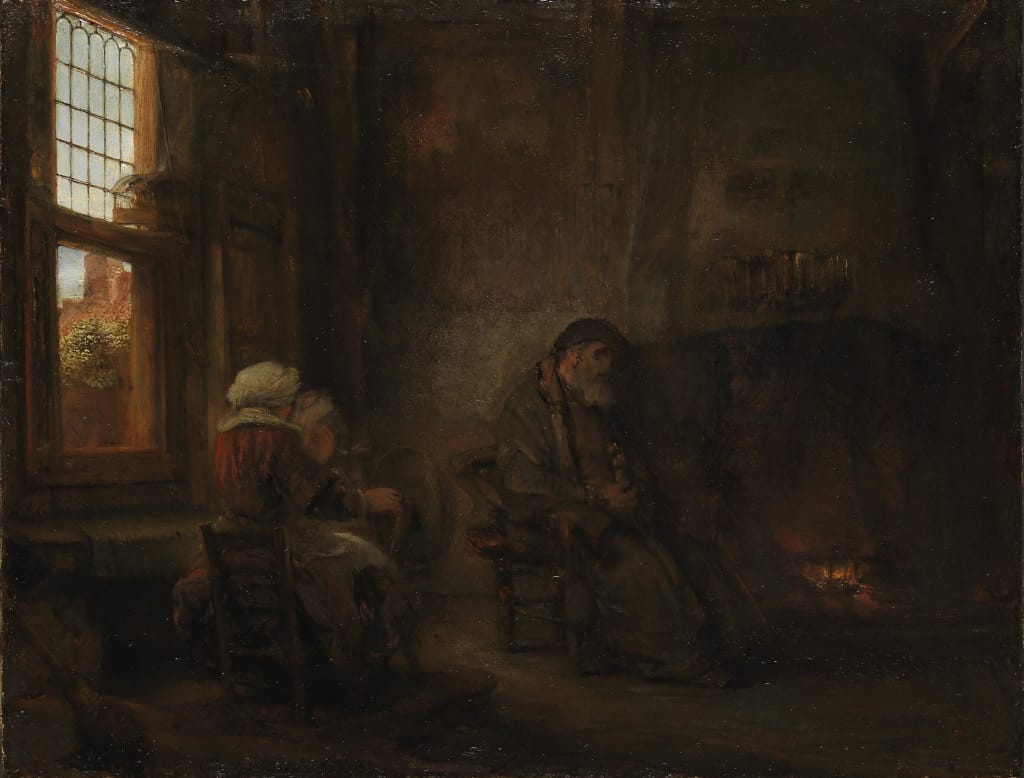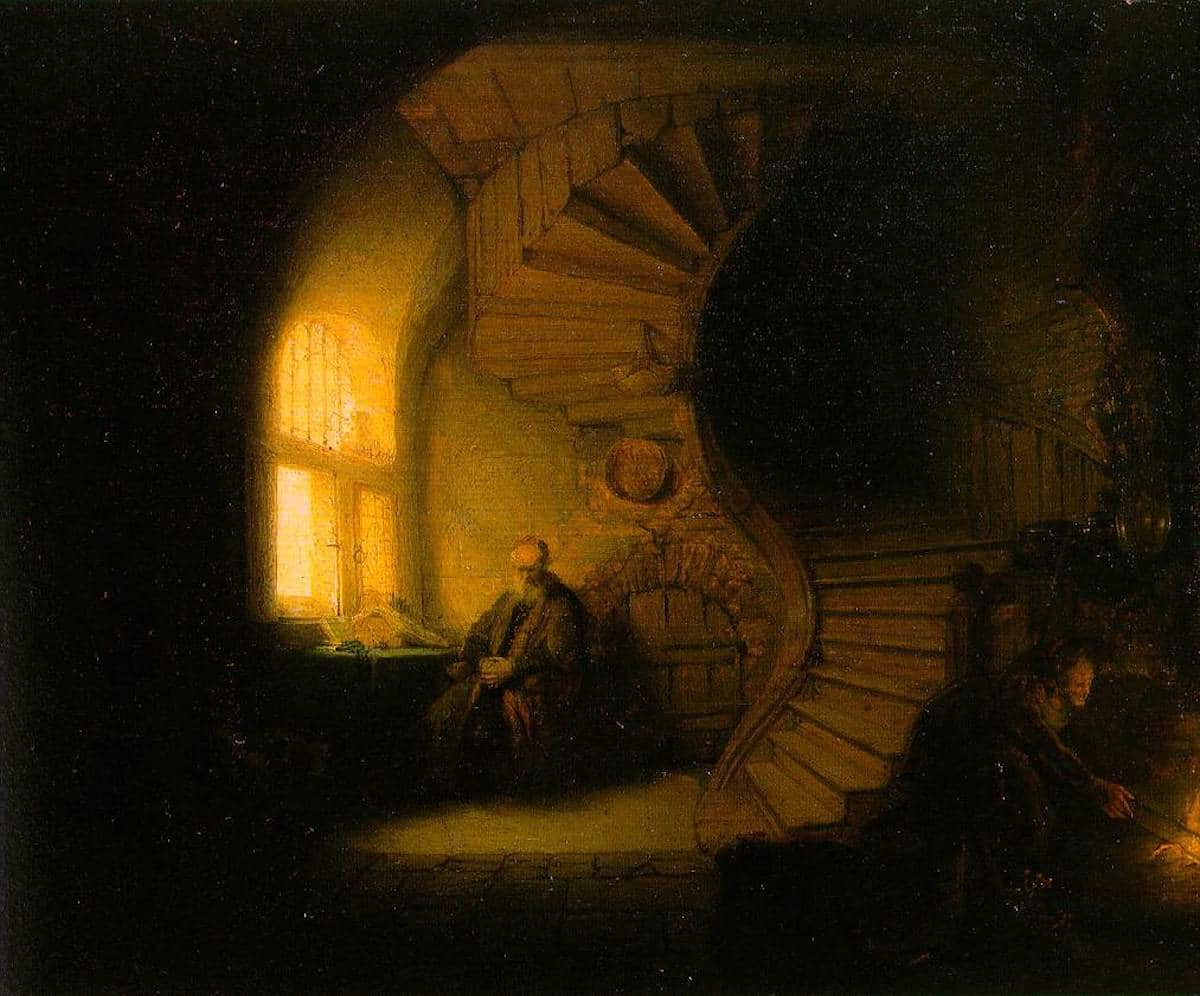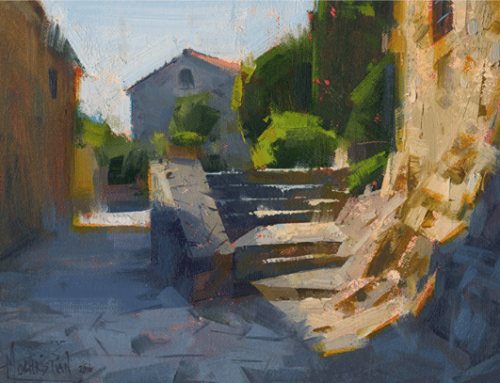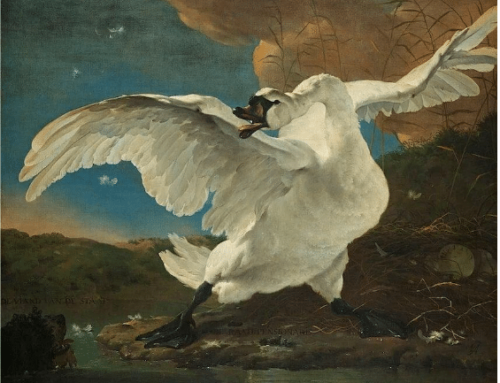The 17th century oil painting Philosopher in Meditation by Rembrandt van Rijn has become an icon of philosophy (it’s been used on the cover of textbooks on the subject), largely, I’d argue, because of Rembrandt’s expressive use of light and shadow.
For such a small work (11 x 13 inches), it packs a ton of interest that makes it feel bigger, even expansive, by drawing us deep into its glowing recess, only to spin us back out via the twisting spiral stairs.
Harold Speed singles out this painting in his venerable Oil Painting Techniques and Materials (originally published in 1924) for what he calls Rembrandt’s use of “expressive tone.”
Expressive Tone
Much of Rembrandt comes down to “the dramatic effect of strongly contrasted light and dark masses,” he notes, but “it is in the middle notes of the scale that tone plays its most alluring harmonies.”
Chiaroscuro, the dramatic play between light and dark, was a relatively new ideal in painting at the time. “Strongly contrasted schemes of tone had been in use since the days of Leonardo da Vinci,” Speed reminds us, “but used chiefly to augment the expression of form; whereas Rembrandt used it as an expressive thing in itself, giving it aesthetic value.” Note: in Rembrandt, the values aren’t used to create form, but rather, they express something more intangible – the “felt idea” at the core of the work’e inspiration.
I think one could say the same about Caravaggio (born in 1571 to Rembrandt’s 1601), but whereas the Italian played up the contrast between extremes of light and dark for the sake of drama, Rembrandt took what we might call a more tonalist approach, exploring the expressive potential of the subtle tonalities between the extremes.
Pictures full of half-light tonalities suggest mood, mystery, memories, dreams, and visions. In this reading, if paintings corresponded to a time of day, paintings composed primarily of carefully modulated mid-tones would be edpressive of the dusks and dawns, the drizzly days of rain or fog, the moonlit woods and half-seen haunts of phantom lights, shadows, and shades.
In paintings such as this, it’s the contrasts – the lightness of the lights and the darkness of the darks – that structure and maintain interest in the whole; however, it’s the nuanced intervals between the poles of light and dark that carry the imagination into realms of speculation and intrigue. From a technical perspective, a lot of that comes down to edges.
Back to The Philosopher in Meditation: “The picture is little more than a dark mass, into which is cut a light one with a wonderful light with a wonderful edge,” writes Speed. “But what an immense impression is created, an impression that is brought about, like all immense impressions, by very simple means.” Speed goes on to point out that the expressivity is in the details on this one: “while the light and dark masses of which the picture is composed are very simple, note the wonderful richness and variety in the edge where the two masses join.” (emphasis mine)
Rembrandt’s painting of the old man in the dark, window-lit gloom certainly provides a suggestive image of deep meditation. The circular composition, the spiral staircase like some kind of link between the earthly and the otherworldly or the Divine, and the brooding half-light evoke the realms of deep thought and meditation. However, recently there’s been a controversy over what this painting actually takes as its subject.
There’s good reason to believe Rembrandt’s old man is not a philosopher with head bowed in solemn self-reflection, but rather Tobit, the patriarch from a Jewish/Old Testament story that Rembrandt knew well. The blind Tobit and his wife (just visible in the lower righthand corner tending the hearth fire) await with increasing anxiety the return of their son from perilous travels. Rembrandt treated the same theme in this painting (below)

Rembrandt, Tobias and Anna Awaiting the Return of their Son
The “philosopher” or “old man in meditation” painting is more compelling though, and far more famous. There are some very interesting ins and outs of the “spiral” painting’s colorful history after it left Rembrandt’s studio, due to appear in an upcoming edition of Inside Art.
Rembrandt’s techniques remain relevant for painters of many stripes today, and there are a number of instructional “how to” videos that break them down.




